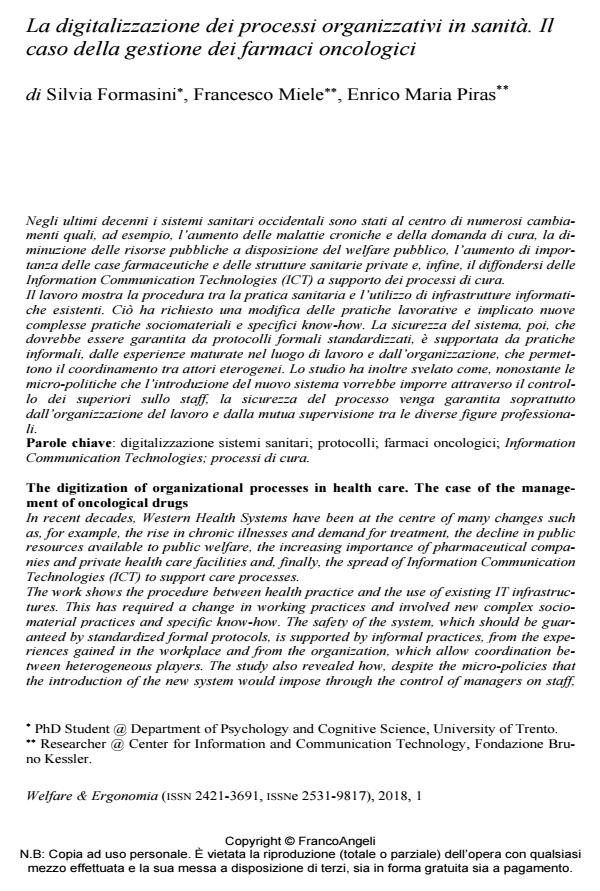La digitalizzazione dei processi organizzativi in sanità. Il caso della gestione dei farmaci oncologici
Titolo Rivista WELFARE E ERGONOMIA
Autori/Curatori Silvia Formasini, Francesco Miele, Enrico Maria Piras
Anno di pubblicazione 2019 Fascicolo 2018/1
Lingua Italiano Numero pagine 17 P. 103-119 Dimensione file 448 KB
DOI 10.3280/WE2018-001006
Il DOI è il codice a barre della proprietà intellettuale: per saperne di più
clicca qui
Qui sotto puoi vedere in anteprima la prima pagina di questo articolo.
Se questo articolo ti interessa, lo puoi acquistare (e scaricare in formato pdf) seguendo le facili indicazioni per acquistare il download credit. Acquista Download Credits per scaricare questo Articolo in formato PDF

FrancoAngeli è membro della Publishers International Linking Association, Inc (PILA)associazione indipendente e non profit per facilitare (attraverso i servizi tecnologici implementati da CrossRef.org) l’accesso degli studiosi ai contenuti digitali nelle pubblicazioni professionali e scientifiche
Negli ultimi decenni i sistemi sanitari occidentali sono stati al centro di numerosi cambiamen-ti quali, ad esempio, l’aumento delle malattie croniche e della domanda di cura, la diminu-zione delle risorse pubbliche a disposizione del welfare pubblico, l’aumento di importanza delle case farmaceutiche e delle strutture sanitarie private e, infine, il diffondersi delle Infor-mation Communication Technologies (ICT) a supporto dei processi di cura. Il lavoro mostra la procedura tra la pratica sanitaria e l’utilizzo di infrastrutture informati-che esistenti. Ciò ha richiesto una modifica delle pratiche lavorative e implicato nuove com-plesse pratiche sociomateriali e specifici know-how. La sicurezza del sistema, poi, che do-vrebbe essere garantita da protocolli formali standardizzati, è supportata da pratiche infor-mali, dalle esperienze maturate nel luogo di lavoro e dall’organizzazione, che permettono il coordinamento tra attori eterogenei. Lo studio ha inoltre svelato come, nonostante le micro-politiche che l’introduzione del nuovo sistema vorrebbe imporre attraverso il controllo dei superiori sullo staff, la sicurezza del processo venga garantita soprattutto dall’organizzazione del lavoro e dalla mutua supervisione tra le diverse figure professionali.
Parole chiave:Digitalizzazione sistemi sanitari; protocolli; farmaci oncologici; Information Communication Technologies; processi di cura.
Silvia Formasini, Francesco Miele, Enrico Maria Piras, La digitalizzazione dei processi organizzativi in sanità. Il caso della gestione dei farmaci oncologici in "WELFARE E ERGONOMIA" 1/2018, pp 103-119, DOI: 10.3280/WE2018-001006